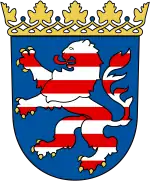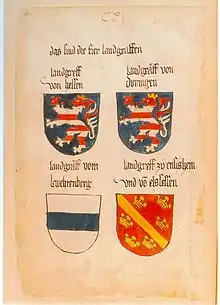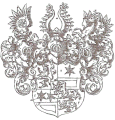The coat of arms of the German state of Hesse was introduced in 1949. It is based on the historical coat of arms of the Ludovingian landgraves of Hesse and Thuringia. The lion on the modern arms does not wear a crown or hold a sword, as it does on the arms of the Grand Duchy.[1]
| Coat of arms of Hesse | |
|---|---|
 | |
| Armiger | The Hesse State Government |
| Blazon | Azure a lion rampant barry of ten argent and gules, armed or |
| Other elements | leaf crown |
History
 The Ludovingian lion barry in the Ingeram Codex of 1459, given as the coat of arms of the landgraves of Hesse and Thuringia
The Ludovingian lion barry in the Ingeram Codex of 1459, given as the coat of arms of the landgraves of Hesse and Thuringia Coat of arms of the landgrave of Hesse in Siebmacher's Wappenbuch (1703)[2]
Coat of arms of the landgrave of Hesse in Siebmacher's Wappenbuch (1703)[2] Lesser coat of arms of the Grand Duchy of Hesse, using the coat of arms of the duchy itself, with the crown of a Grand Duchy and two lions as supporters (1806 to 1918)
Lesser coat of arms of the Grand Duchy of Hesse, using the coat of arms of the duchy itself, with the crown of a Grand Duchy and two lions as supporters (1806 to 1918).svg.png.webp) Greater coat of arms of the Grand Duchy of Hesse in 1902
Greater coat of arms of the Grand Duchy of Hesse in 1902 The coat of arms of the Prussian province of Hesse-Nassau
The coat of arms of the Prussian province of Hesse-Nassau Design by Gerhard Matzat (1949)
Design by Gerhard Matzat (1949)
References
- ↑ "Bedeutung und wappengeschichtliche Herkunft | Informationsportal Hessen". www.hessen.de (in German). Retrieved 2018-05-13.
- ↑ Siebmacher, Johann (1703). Erneuertes und vermehrtes Wappenbuch... Nürnberg: Adolph Johann Helmers. pp. Part I Table 8.
See also
- Coat of arms of Prussia
- Coat of arms of Germany
- Coat of arms of Thuringia, which has a similar appearance.
- Origin of the coats of arms of German federal states.
This article is issued from Wikipedia. The text is licensed under Creative Commons - Attribution - Sharealike. Additional terms may apply for the media files.
.svg.png.webp)